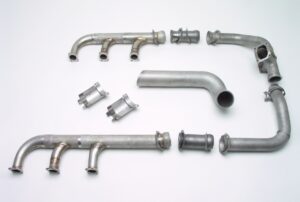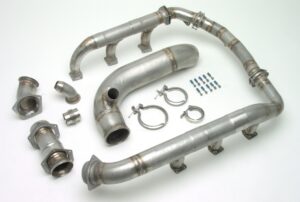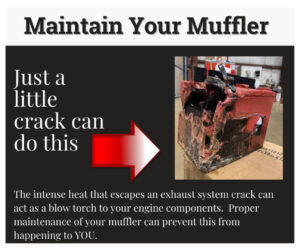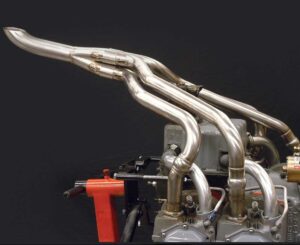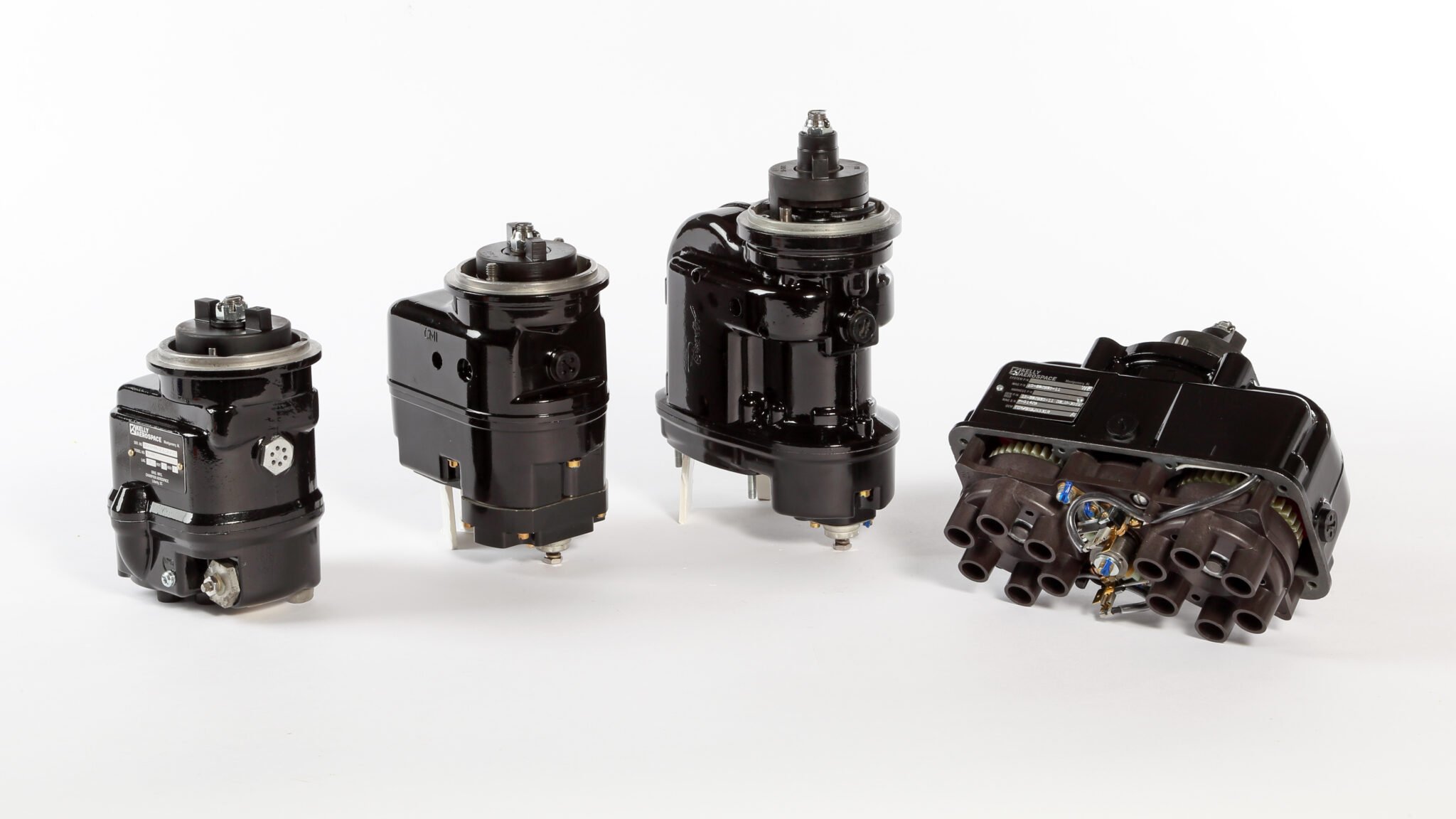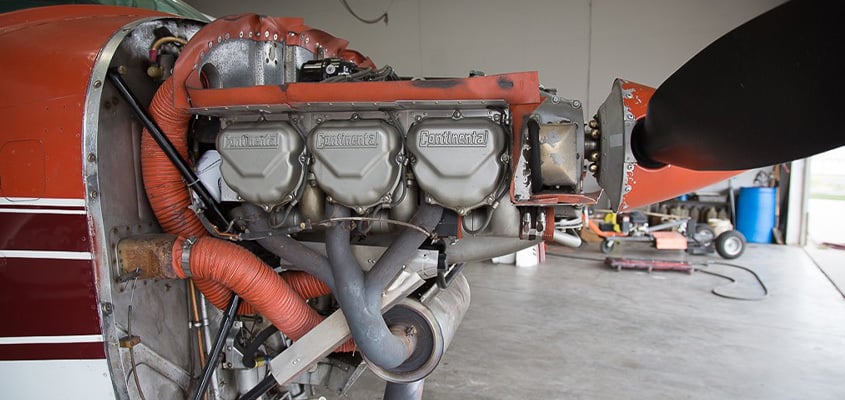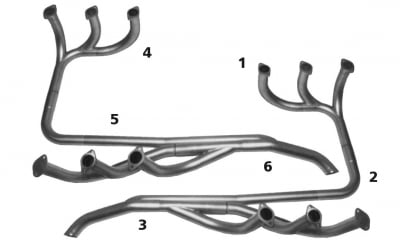Your Aircraft Exhaust System: Tips for Inspection and Maintenance
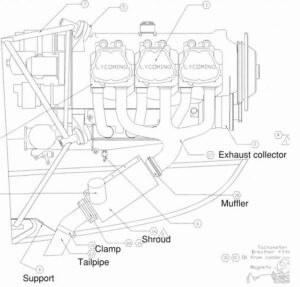
Due to the extremely hot and corrosive conditions in which aircraft exhaust systems operate, it’s necessary to conduct thorough inspections and perform regular maintenance to ensure their proper functioning and safety. An aircraft’s exhaust system is a critical component of any aircraft, and proper inspection and maintenance ensures its safety and reliability.
In this blog post, we’ll discuss how to inspect and maintain the aircraft exhaust system on your aircraft.
What are Common Problems with Aircraft Exhaust Systems?
There are several issues that can arise with your aircraft exhaust system:
1. Cracks or corrosion in aircraft exhaust parts
Over time, aircraft exhaust parts can develop cracks or corrode due to exposure to high temperatures and corrosive exhaust gases.
2. Leaks in the aircraft exhaust system
Leaks can occur at the exhaust manifold, muffler, or tailpipe connections. Leaks in the aircraft exhaust system can lead to decreased engine performance, increased fuel consumption, and potential carbon monoxide poisoning in the cockpit.
3. Loose or missing fasteners to aircraft exhaust parts
Vibrations during flight can cause fasteners on the aircraft exhaust parts to loosen or fall off, leading to exhaust leaks or damage to the system.
4. Failed or damaged aircraft mufflers
The aircraft mufflers can fail due to age, corrosion, or impact damage, leading to reduced engine performance and increased noise levels.
5. Improper installation of aircraft exhaust components
Improper installation of the aircraft exhaust system can lead to exhaust leaks – resulting in damage to the system, decreased engine performance, and major aircraft exhaust repair.
It’s important to have regular inspections of the aircraft exhaust system to catch any issues early and address them before they become a safety concern.
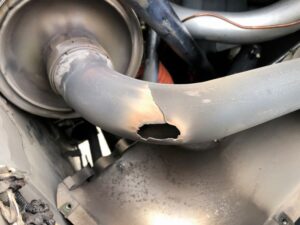
Tips for Aircraft Exhaust System Inspection:
- The first step in inspecting your aircraft’s exhaust system is to conduct a visual inspection.
- Look for signs of damage or wear on the aircraft exhaust pipes, mufflers, and tailpipe.
- Check for any cracks, corrosion, or loose connections in all of the aircraft exhaust components.
- Ensure that the aircraft exhaust system is securely mounted to the engine and airframe.
- Next, you need to perform a leak test.
- One effective method for exhaust system leak detection is using a shop vacuum, duct tape, and soapy water.
- First, insert the shop vacuum hose into the cold exhaust tailpipe and seal it tightly with duct tape.
- Make sure the vacuum switch and/or hose attachment is set to “blow” to ensure that air blows out of the hose instead of being pulled into the vacuum.
- Next, turn on the vacuum cleaner and allow the air blown into the aircraft exhaust parts and system to pressurize it for leak inspection.
- Apply the soapy solution to the slip joints, clamps, and welds around the muffler to check for leakage.
- Any leaks will be immediately visible as the solution begins to bubble. It’s important to inspect and fix any leaks found, as they can lead to decreased engine performance and safety hazards.
Finally, inspect the aircraft exhaust system for any signs of exhaust residue. Carbon monoxide is a poisonous gas that can be produced by the combustion of fuel in the engine. Aviation exhaust residue can be a sign of a problem with the engine, and any issues should be addressed immediately.

Aircraft Muffler Inspection:
- Remove all heat deflectors and muffler shrouds when inspecting all of the aircraft exhaust components.
- Check for signs of overheating and metal fatigue, such as bulges or wrinkles on the muffler.
- Pay attention to the sidewalls and lower sections of the aircraft mufflers, which are prone to deterioration and thinning.
- Use an awl to probe areas of suspected thinning to assess the material’s thickness.
- Inspect the internal structure of the aircraft mufflers using a bright light or inspection camera.
- Straight tailpipes can provide access for a bright flashlight and inspection mirror.
- For aircraft exhaust systems with tailpipes that have bends or are located at a distance from the muffler, use an inspection camera with a small-diameter, long, flexible shaft.
- Be on the lookout for loose or broken baffles inside the muffler, which can partially obstruct the aircraft exhaust outlet and create hotspots that cause premature metal fatigue.
What is the Maintenance for an Aircraft Exhaust System?
Maintenance of the aircraft exhaust system is essential to ensure that it remains in good condition and operates efficiently. Here are some tips for maintaining the exhaust system:
1. Regular cleaning
The aircraft exhaust system should be cleaned regularly to remove any debris or residue that can accumulate in the system. This can be done by using a wire brush or scraper to remove any carbon deposits from the aircraft exhaust parts.
2. Replacement of parts
Aviation exhaust system parts should be replaced when they are worn out or damaged. This includes exhaust pipes, aircraft mufflers, and tailpipes.
3. Lubrication
The aircraft exhaust system should be lubricated regularly to ensure that the moving parts remain in good condition. Use a high-temperature lubricant for this purpose.
4. Heat management
Proper heat management is crucial for the safe and efficient operation of the aircraft exhaust components. . Ensure that the aircraft exhaust system is properly insulated to prevent excessive heat from damaging the engine or other components.
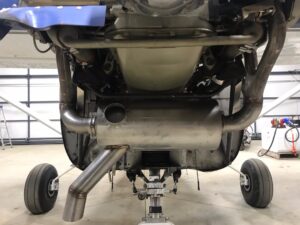
Tips for Operating Aircraft Exhaust Systems:
To ensure the longevity of your airplane’s exhaust system, it’s important to follow certain maintenance and operating practices.
Here are some best practices to keep in mind:
- Avoid using pencils to mark exhaust components during maintenance, as the graphite can weaken the metal and lead to cracks when the aircraft exhaust heats up during use.
- During engine runup and magneto checks, be careful not to accidentally turn the ignition switch all the way off instead of selecting one magneto. If this happens and the engine starts to die, it’s best to let it shut down and restart it rather than suddenly turning the switch back on, which can cause a severe after-fire in the aircraft exhaust system.
- As with all engine and aviation exhaust components, try to keep the engine as cool as possible on climb out and as warm as possible on descent to minimize sudden temperature changes, which can help extend the service life of the aircraft exhaust components.
Aviation Exhaust System Service & Repair with QAA 
The aircraft exhaust system is a critical component of any piston engine aircraft. Proper inspection and maintenance are necessary to ensure that the exhaust system operates efficiently and safely.
Please note that while the tips provided can be helpful for inspecting and maintaining your aircraft’s exhaust system, it’s always recommended to consult with a trained and licensed aircraft mechanic or aviation exhaust repair specialist for any maintenance or repairs.
